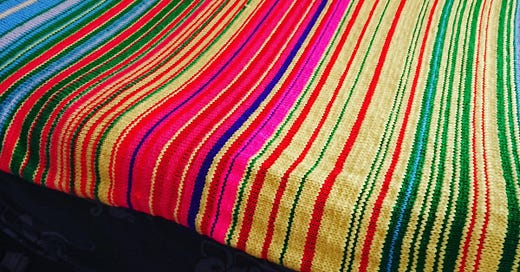In this week’s edition: clean hands, full hearts, can’t lose. Also knitters map climate change, cooking in migrant border camps, and how to ferment your own mustard.
If someone shared this newsletter with you, subscribe below.

It took me 24 years to learn how to wash my hands properly. It was my trial shift at the Kappacasein stall at Borough Market, and my co-worker led me to the sink shed and blew my mind...hygienically speaking.
Wash my wrists? Scrub between my fingers? Lather for 20 seconds?! Who knew! I had no idea how to wash my hands properly, and outside of healthcare professionals and diligent food handlers, I don’t think I was alone in that knowledge gap. Due to the coronavirus pandemic, it seems like the rest of the world is finally becoming attuned to this basic tenant of good health and hygiene. It’s the World Health Organization’s number one tip for stopping the spread of the virus. It’s also become fabulous international meme fodder!


I live in Florida’s Lee County, which recently had its first coronavirus patient death. As a healthy, youngish person, I’m not as worried for myself as I am for my parents, both septuagenarians recently returned from an international trip, and one of whom has serious respiratory issues. So I called them up and reminded them to wash their hands. They both laughed at me. “I don’t think washing my hands is going to make any difference at all!” Of course, I’m sure their cavalier attitude is influenced by the performative nonchalance of the on-air talent at Fox News.
That horror aside, I think people tend to underestimate the power of handwashing because society has developed a tendency to mistake hygiene for sterility. This confusion can be seen in the misguided comfort felt by seeing a food handler wearing gloves. At Ground Floor Farm, we would post gorgeous photos of hands packing kimchi or mixing bread dough or sprinkling a finishing touch of sea salt on a salad to Facebook. Always there would be some horrified comments. “Did you run out of gloves?” “Someone should report this to the health inspector!” During the early days, I would gently try to change hearts and minds: “Actually! Gloves [just like face masks] tend to give the wearer a sense of false security and aren’t that effective at reducing bacterial contamination, unlike proper handwashing, which the CDC calls one of the most important steps we can take to avoid getting sick and spreading germs.”
As a fermentation geek, I simply cannot talk about microbes without diving into the nuance. The vast majority of microbes are actually beneficial to our health. Exposure to a diversity of microbes, particularly as children and through food, may well be key to a strong immune system. Also, microbes make food taste really nice. But baddies like coronavirus must be taken seriously.
The future may depend on it. And that means taking the recommended 20 seconds to wash 👏 those 👏 damn 👏 hands.
Is counting to 20 seconds too boring? Don’t worry. My favorite Swedish pop supergroup has you covered.
Feel free to sing out loud, especially in public.
Mamma mia, here I go again
My my, how can I resist you?
Mamma mia, does it show again
My my, just how much I've missed you?
Yes, I've been brokenhearted
Blue since the day we parted
Why, why did I ever let you go?
Congrats, you now have clean hands.

love,
Jackie
Are your hands washed? Great! Now click that button and share this issue:

Citizen Science Corner
Temperature Scarves and Blankets
Besides handwashing, one of the most important ways to prevent the spread of coronavirus is social distancing — in other words, avoid public gatherings and reduce the likelihood of contact between people carrying the virus. Looking to start your own self-quarantine? Maybe it’s time to take up knitting.
Knitters have discovered a calming way to contribute to science in these distressing times. To keep track of local changes in the climate, people have started knitting “temperature scarves” and temperature blankets.



By using data from the National Oceanic and Atmospheric Administration, “knitters would represent in colors from sunny yellow to fiery red and icy blue. Mr. Connelly and his colleagues called the endeavor the Tempestry Project and, since then, they have sold more than 1,500 kits worldwide,” according to the NY Times
The Tempestry Project was founded in 2017 as a reaction against the government’s anti-climate science rhetoric over the last few years. Like needlework of the past, these are more than just vibrant designs. They’re a fashion statement, a political statement, a way of preserving data, and even a teaching tool that conservationists have started using in their classrooms. Check out the Tempestry Project and their knit kits.


Fresh links
🍳In the Midst of a Border Crisis, Cooking Is About More Than Survival | Bon Appetit
The Trump administration’s immigrant policy best known as “Remain in Mexico” forces migrants to wait on the Mexico side of the border while their asylum cases are heard. They live in camps, far from lawyers, sometimes waiting years for their cases to be processed. Odds are slim for migrants hoping to be granted asylum, and while waiting, they face threats of kidnapping and violence.
Cooking is essential to helping pass the time, and to soothe the body, mind, and soul.
Journalist Michelle García observes the way asylees use food to keep up spirits. She sees two Honduran boys describe their favorite breakfast, a meal known as baleada, to a Salvadoran girl. In the ramshackle, makeshift camps, their parents pool together their money to form a cooking cooperative and fight issues like malnourishment. They make dishes for the community like chicken soup or plantains, using bottled water to cook to avoid water-borne illnesses as they wait to learn about their futures.
Also in the camp is a volunteer group called Team Brownsville, which provides meals for migrants. Co-founder Michael Benavides, a Gulf War veteran, said he sees PTSD everywhere he goes in the camp. Team Brownsville feeds several hundred of the couple thousand people there with daily operations including “360 eggs, 10 pounds of sausage, six pounds of beans, and 66 pounds of corn tortillas.”
You can donate to Team Brownsville here:
https://www.teambrownsville.org/
💵Living Without a Living Wage | Washington Post
Pulitzer Prize-winning reporter Eli Saslow shadows Waffle House waitress Sara Fearrington during a week of her life in Durham. N.C.
Despite a booming economy, Fearrington is one of millions struggling to survive (living “tip to tip” as she puts it) in a system that has failed her. Between parenting and caring for her husband, Fearrington takes as many double shifts at Waffle House as she can. The hard work doesn’t help her catch up on her debts:
She had been both employed and poor for her entire adulthood, but only in the past few months had she learned that officially made her a part of something: the low-wage workforce, the fastest growing segment of a splintering American economy that continues to expand at both extremes. There were a record 53 million low-wage workers last year, or about 44 percent of all active workers in the United States. More than half were women. Two-thirds were in their prime earning years. Forty percent were supporting children at home. They earned a median annual salary of $17,950.
Sara’s own version of those statistics meant awakening at 4:40 a.m. to catch the first city bus of the day because she didn’t have a car, and asking friends to share medications because she didn’t have health insurance, and working the past 11 years without taking a vacation because she couldn’t afford the time off. But what she resented most about being one of the working poor was the constant anxiety that came from having no margin for error. At every moment, the smallest problem threatened to upend the fragile balance of her life, and now on a day when she had $28.42 in savings and $2.09 in checking, she arrived home from the bus station to find a big problem waiting in an envelope on her porch.
“Eviction notice,” a letter read. “This is a 10-day warning.”
Fearrington has joined NC Raise Up to fight for a $15 minimum wage in the state. At the end of the article, she gives a speech outside the Capitol in Raleigh with the group. The governor declined to attend as did most elected state lawmakers. She shares her life story and receives accolades from those in attendance but wonders how long it’ll take to build the momentum for the change she and millions of others need.
🐋 Two Heartbeats a Minute | Invisibilia
I don’t want to give too much away about this season-opening episode of the podcast Invisibilia. It’s about the eerie power of whale songs; a team of scientists searching for the keys to decode and translate animal language; and the things that do and do not get human beings to give a damn about the planet. Moreover, it straddles the seeming pointlessness of individual action around climate change and the vital importance of individual action around climate change. Whether you’re hopeful or hopeless about the future of the species, this episode is a fascinating ride.



Fermented Whole Grain Mustard

Homemade mustard is infinitely more delicious than store bought. The end.
Ingredients
1/3 cup mustard seeds
1/3 cup fruit vinegar (apple cider works great or try Sunshine + Microbes’ own recipe)
1/3 cup beer of choice
1 tablespoon honey
1 teaspoon ground turmeric
1/2 teaspoon salt
big pinch of red pepper flakes
2 tablespoons chopped herbs of choice
2 tablespoons liquid fermentation starter (kombucha, water kefir, leftover brine from veggie ferment, etc)
Optional flavor add-ins: chipotle pepper, garlic, curry powder, kosho, smoked paprika, or whatever your heart desires
Step-by-step
Mix all the ingredients together in a container (I use a mason jar) and loosely cover. Let it sit undisturbed at room temperature, fermenting for 3 days to 2 weeks (the longer, the more sour).
Blend until mustard seeds begin to break apart and a textured paste forms. The mixture will be a little thin initially but will firm up after a few hours in the fridge. Mustard keeps for months (or probably years) stored in the fridge.
Adapted from David Lebovitz, who adapted it from the Joe Beef cookbook

Do’s and Don’ts for quarantine:
Do Not use Tito’s Vodka for hand sanitizer.
Do use various items around the house (say, potatoes, tomatoes, paper cups and chopsticks) to entertain yourself with a homemade game of billiards.
Talk to Us
Send in your comments, mailbag questions, recipe mishaps, or cooking tips: sunshineandmicrobes@gmail.com. Also do us a favor and follow us on Facebook and Instagram.
If you enjoyed this email, please share it with others. If someone forwarded this to you, click the button to sign up:
-------------------------------------------------------------------------------------------------
Sunshine + Microbes team
Jackie Vitale is the current Chef-in-Residence at the Robert Rauschenberg Foundation and co-founder of the Florida Ferment Fest. Her newsletter explores the intersection of food, culture, environment and community.
Matt Levin is a freelance reporter based in Colombia. He edits Sunshine + Microbes and contributes other scraps to each issue.




